Employee Benefits in Financial Accounting: Journals and Analysis
VerifiedAdded on 2023/06/03
|14
|2770
|279
Essay
AI Summary
This essay provides a detailed analysis of employee benefits from a financial accounting perspective, drawing on two academic journals to explore their significance and impact. It examines the positive and negative effects of employee benefits on employee productivity, organizational commitment, and overall financial performance. The essay highlights the importance of effective benefits management, communication, and employee participation in maximizing the value of these benefits. Furthermore, it discusses the roles of accountants, regulators, and shareholders in ensuring proper accounting treatment, compliance with standards, and strategic alignment of benefits with organizational goals. The analysis includes a comparison of the two journals, noting similarities and differences in their findings, and concludes with key learnings for various stakeholders in the financial accounting and management of employee benefits.
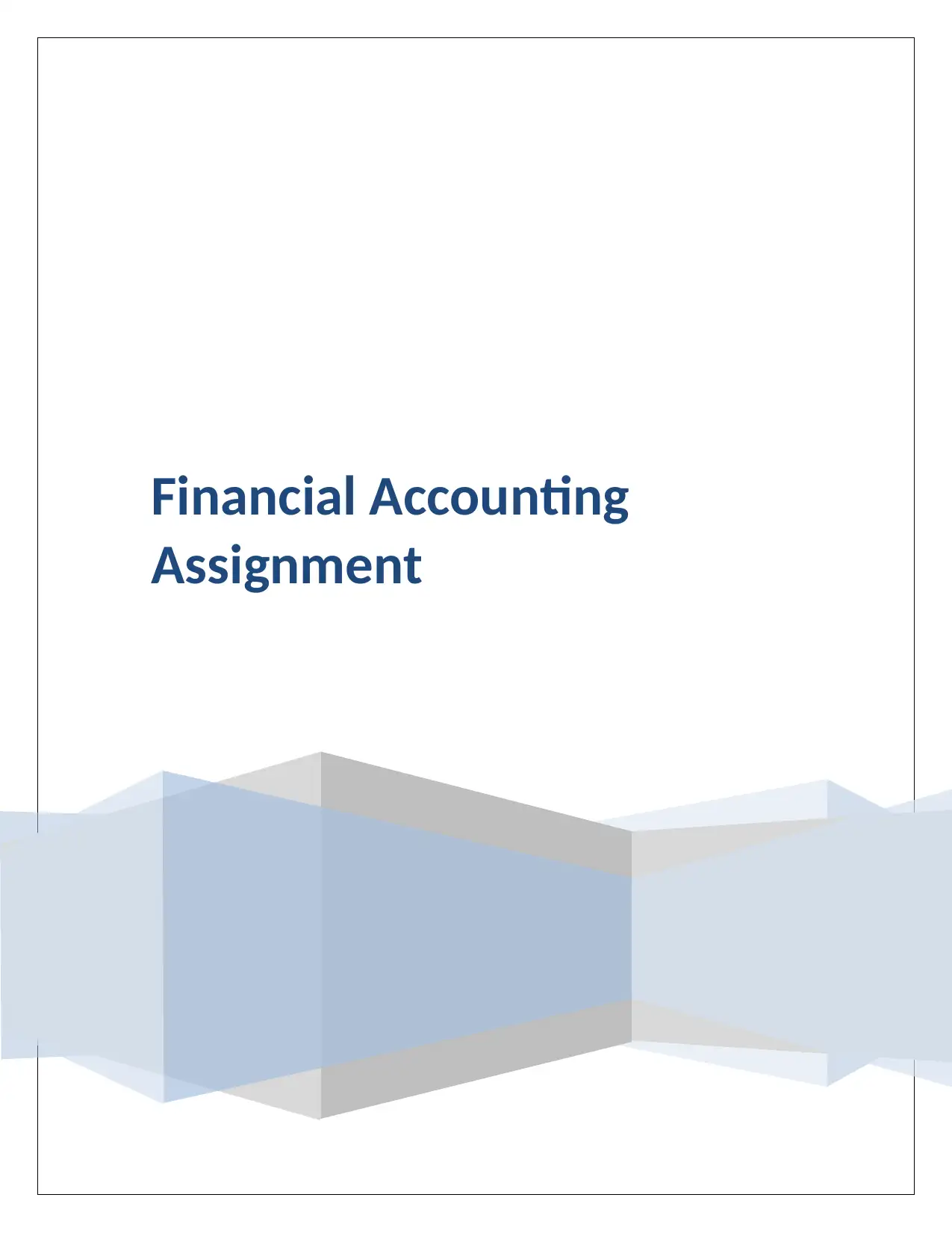
Financial Accounting
Assignment
Assignment
Paraphrase This Document
Need a fresh take? Get an instant paraphrase of this document with our AI Paraphraser
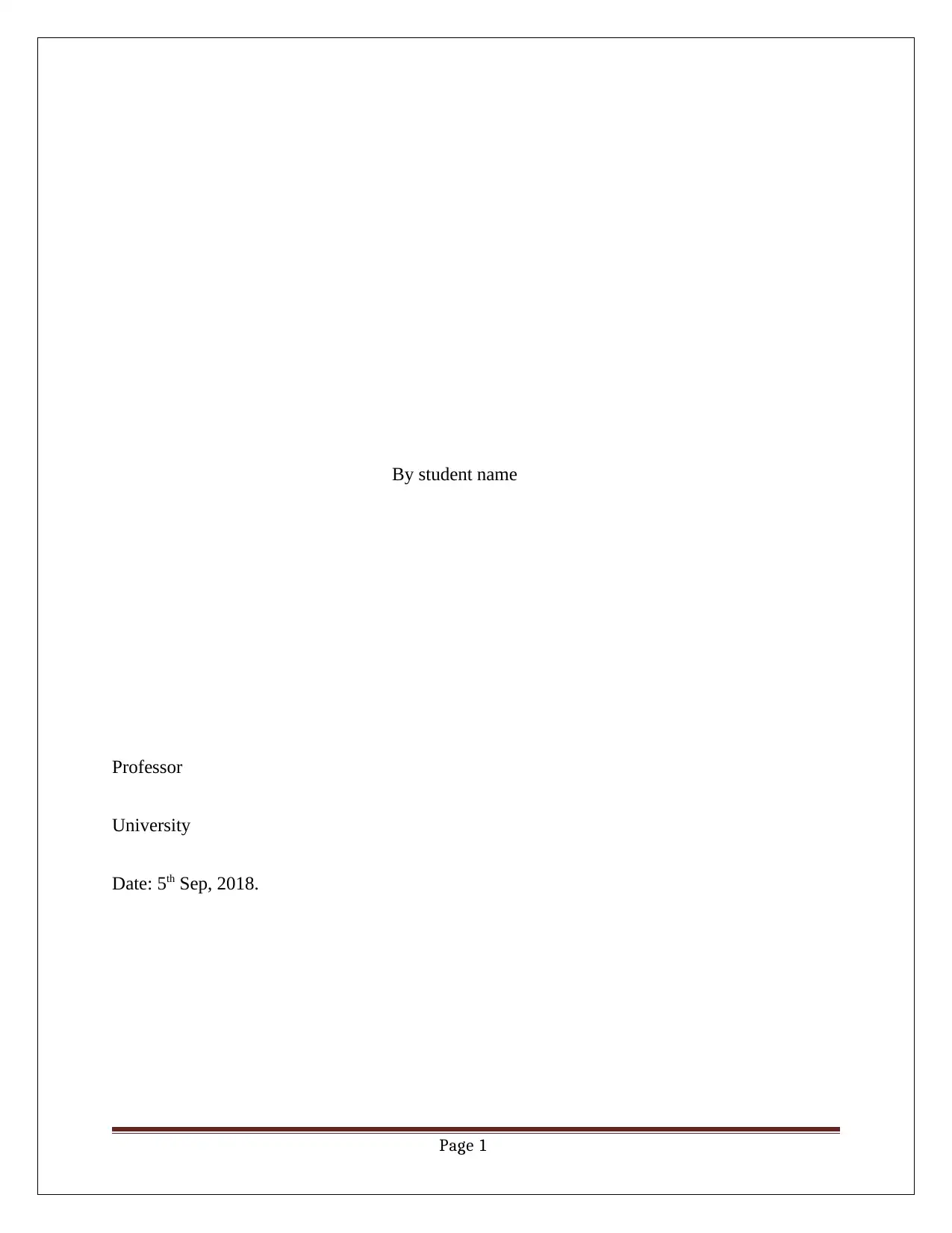
By student name
Professor
University
Date: 5th Sep, 2018.
Page 1
Professor
University
Date: 5th Sep, 2018.
Page 1
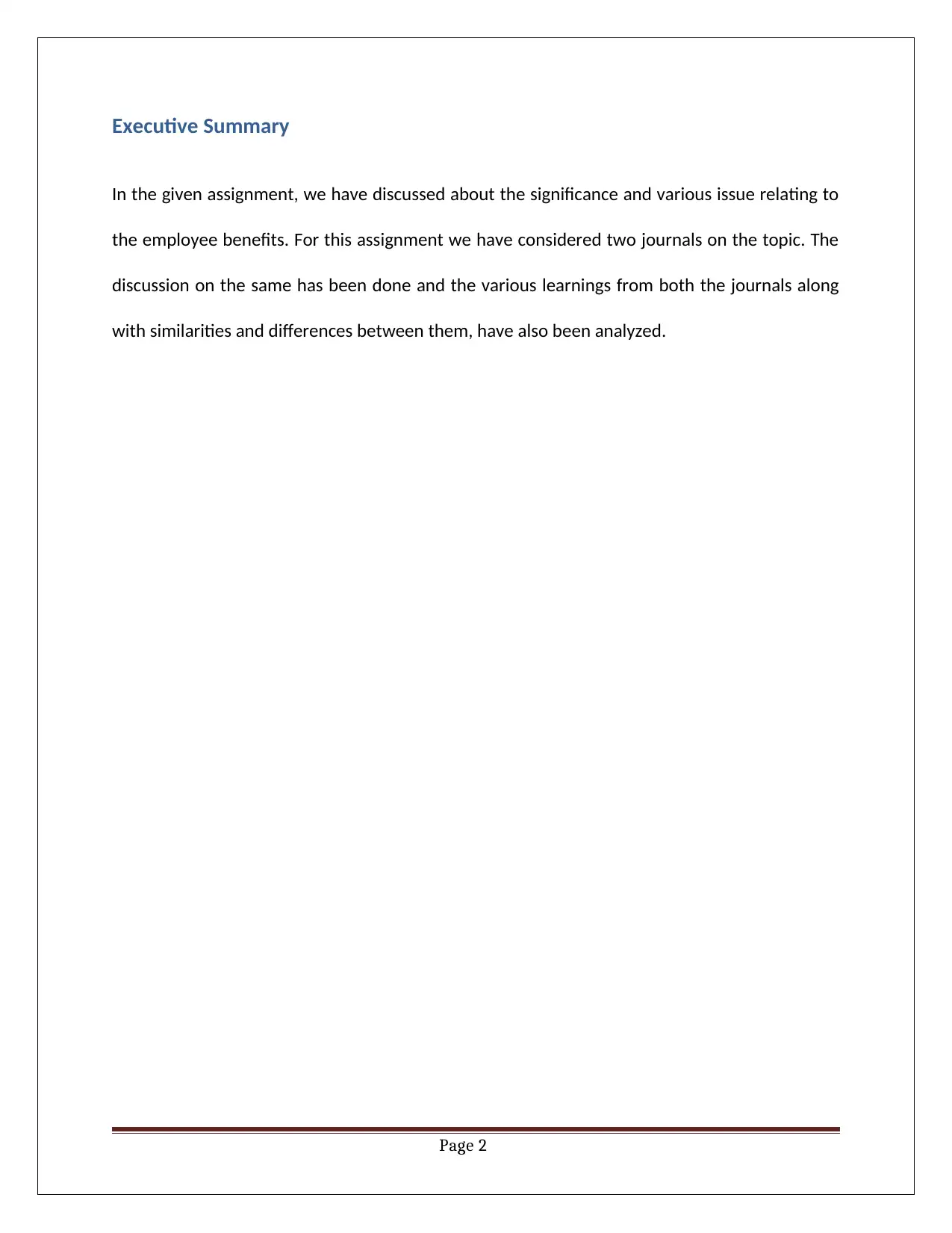
Executive Summary
In the given assignment, we have discussed about the significance and various issue relating to
the employee benefits. For this assignment we have considered two journals on the topic. The
discussion on the same has been done and the various learnings from both the journals along
with similarities and differences between them, have also been analyzed.
Page 2
In the given assignment, we have discussed about the significance and various issue relating to
the employee benefits. For this assignment we have considered two journals on the topic. The
discussion on the same has been done and the various learnings from both the journals along
with similarities and differences between them, have also been analyzed.
Page 2
⊘ This is a preview!⊘
Do you want full access?
Subscribe today to unlock all pages.

Trusted by 1+ million students worldwide
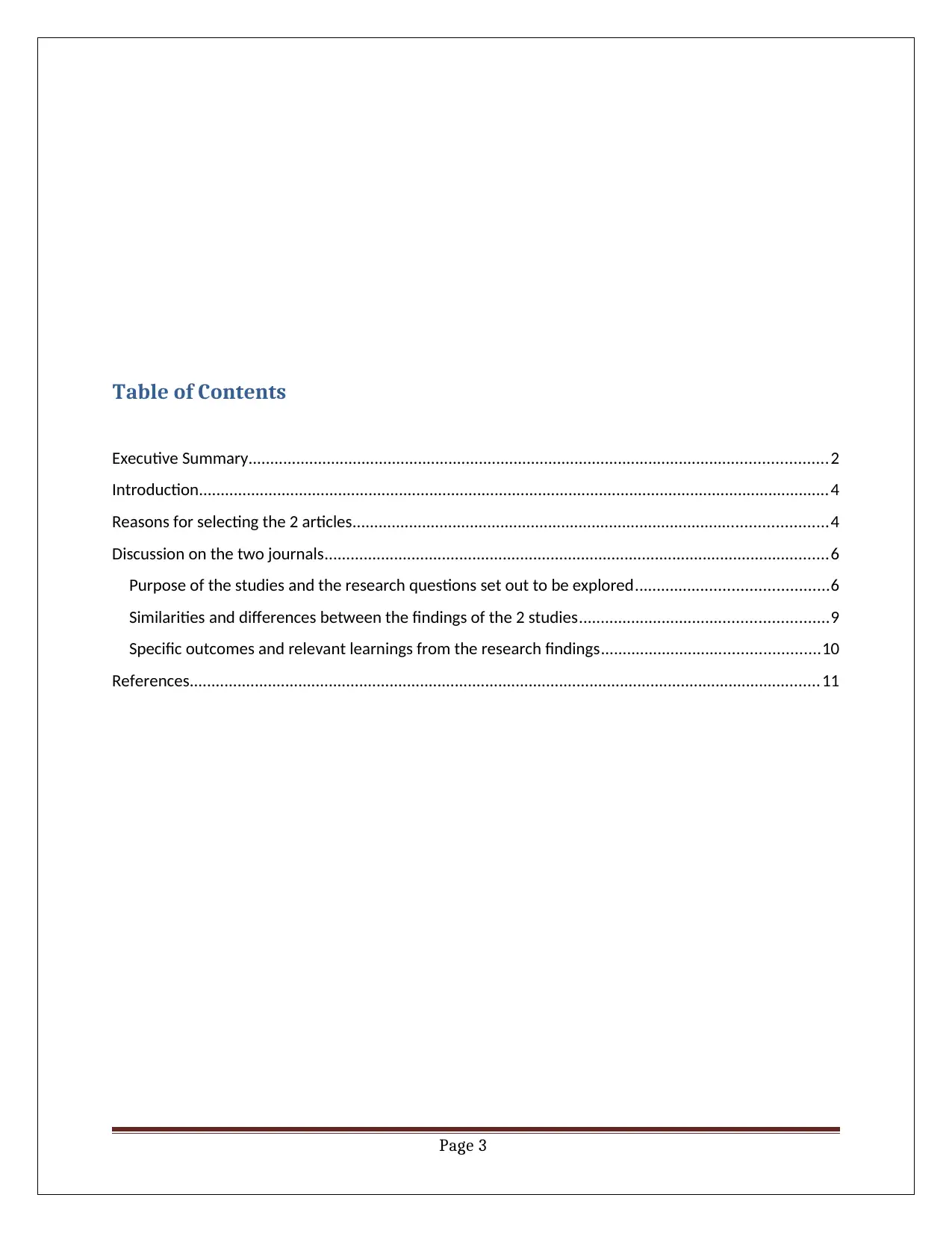
Table of Contents
Executive Summary.....................................................................................................................................2
Introduction.................................................................................................................................................4
Reasons for selecting the 2 articles.............................................................................................................4
Discussion on the two journals....................................................................................................................6
Purpose of the studies and the research questions set out to be explored............................................6
Similarities and differences between the findings of the 2 studies.........................................................9
Specific outcomes and relevant learnings from the research findings..................................................10
References.................................................................................................................................................11
Page 3
Executive Summary.....................................................................................................................................2
Introduction.................................................................................................................................................4
Reasons for selecting the 2 articles.............................................................................................................4
Discussion on the two journals....................................................................................................................6
Purpose of the studies and the research questions set out to be explored............................................6
Similarities and differences between the findings of the 2 studies.........................................................9
Specific outcomes and relevant learnings from the research findings..................................................10
References.................................................................................................................................................11
Page 3
Paraphrase This Document
Need a fresh take? Get an instant paraphrase of this document with our AI Paraphraser
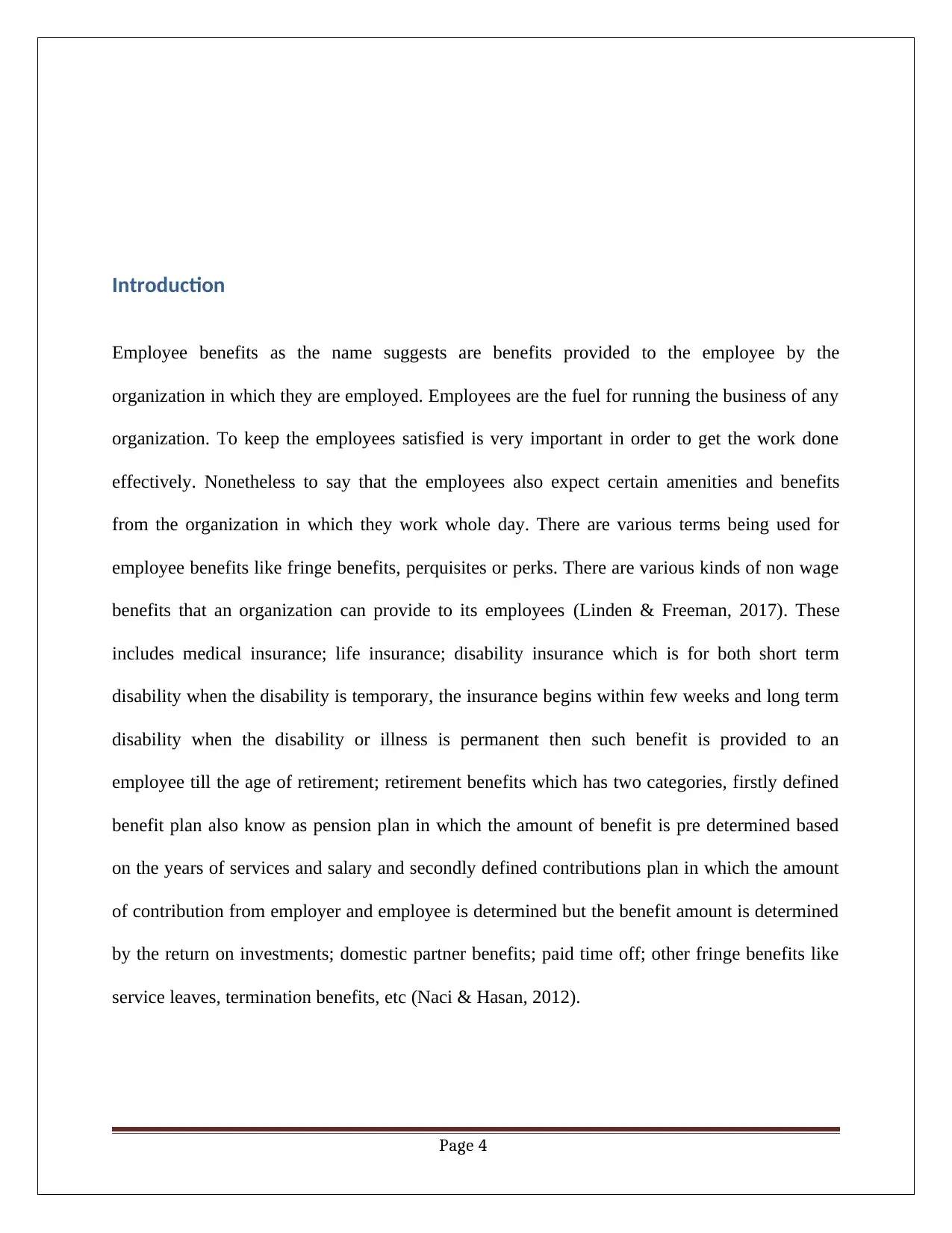
Introduction
Employee benefits as the name suggests are benefits provided to the employee by the
organization in which they are employed. Employees are the fuel for running the business of any
organization. To keep the employees satisfied is very important in order to get the work done
effectively. Nonetheless to say that the employees also expect certain amenities and benefits
from the organization in which they work whole day. There are various terms being used for
employee benefits like fringe benefits, perquisites or perks. There are various kinds of non wage
benefits that an organization can provide to its employees (Linden & Freeman, 2017). These
includes medical insurance; life insurance; disability insurance which is for both short term
disability when the disability is temporary, the insurance begins within few weeks and long term
disability when the disability or illness is permanent then such benefit is provided to an
employee till the age of retirement; retirement benefits which has two categories, firstly defined
benefit plan also know as pension plan in which the amount of benefit is pre determined based
on the years of services and salary and secondly defined contributions plan in which the amount
of contribution from employer and employee is determined but the benefit amount is determined
by the return on investments; domestic partner benefits; paid time off; other fringe benefits like
service leaves, termination benefits, etc (Naci & Hasan, 2012).
Page 4
Employee benefits as the name suggests are benefits provided to the employee by the
organization in which they are employed. Employees are the fuel for running the business of any
organization. To keep the employees satisfied is very important in order to get the work done
effectively. Nonetheless to say that the employees also expect certain amenities and benefits
from the organization in which they work whole day. There are various terms being used for
employee benefits like fringe benefits, perquisites or perks. There are various kinds of non wage
benefits that an organization can provide to its employees (Linden & Freeman, 2017). These
includes medical insurance; life insurance; disability insurance which is for both short term
disability when the disability is temporary, the insurance begins within few weeks and long term
disability when the disability or illness is permanent then such benefit is provided to an
employee till the age of retirement; retirement benefits which has two categories, firstly defined
benefit plan also know as pension plan in which the amount of benefit is pre determined based
on the years of services and salary and secondly defined contributions plan in which the amount
of contribution from employer and employee is determined but the benefit amount is determined
by the return on investments; domestic partner benefits; paid time off; other fringe benefits like
service leaves, termination benefits, etc (Naci & Hasan, 2012).
Page 4
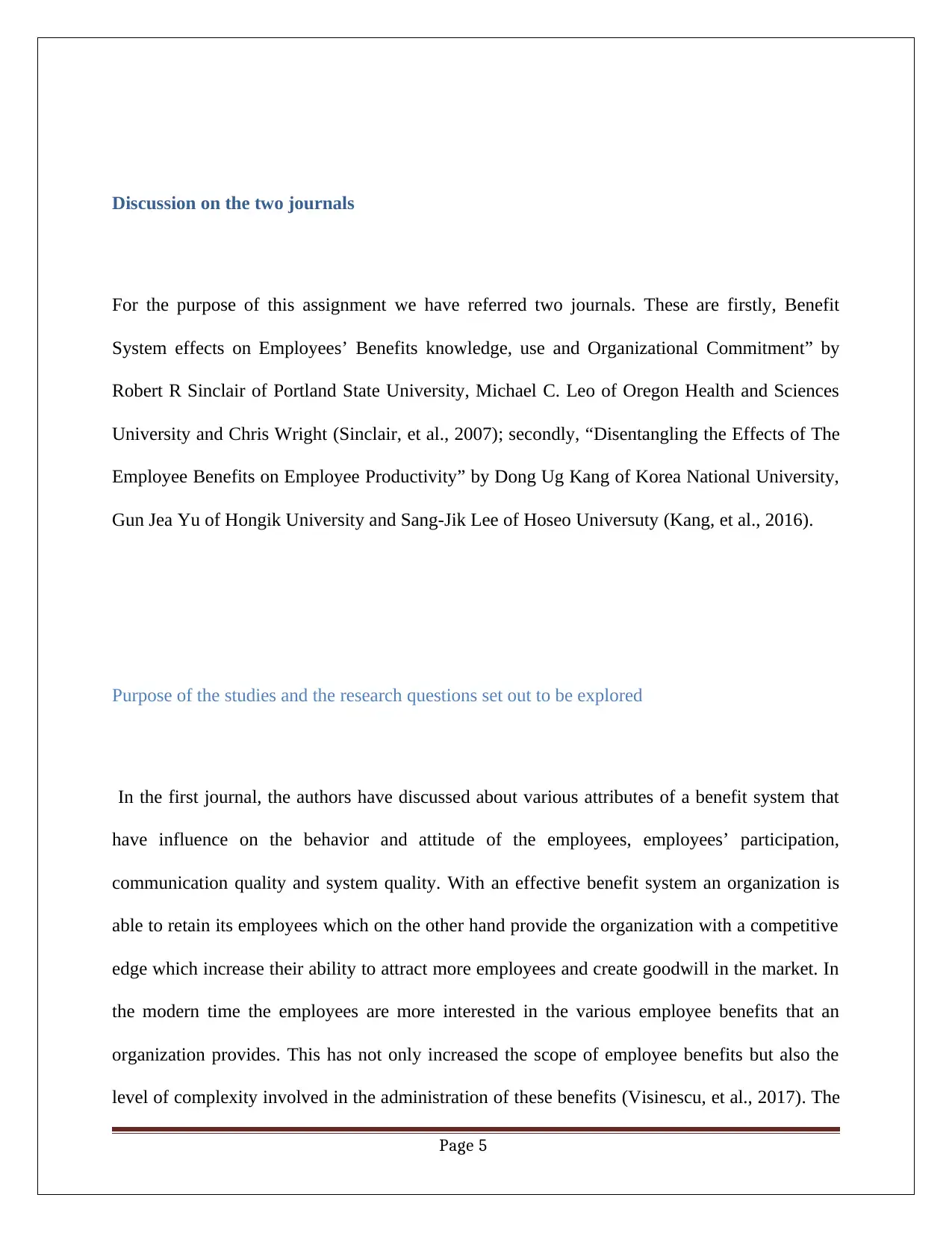
Discussion on the two journals
For the purpose of this assignment we have referred two journals. These are firstly, Benefit
System effects on Employees’ Benefits knowledge, use and Organizational Commitment” by
Robert R Sinclair of Portland State University, Michael C. Leo of Oregon Health and Sciences
University and Chris Wright (Sinclair, et al., 2007); secondly, “Disentangling the Effects of The
Employee Benefits on Employee Productivity” by Dong Ug Kang of Korea National University,
Gun Jea Yu of Hongik University and Sang-Jik Lee of Hoseo Universuty (Kang, et al., 2016).
Purpose of the studies and the research questions set out to be explored
In the first journal, the authors have discussed about various attributes of a benefit system that
have influence on the behavior and attitude of the employees, employees’ participation,
communication quality and system quality. With an effective benefit system an organization is
able to retain its employees which on the other hand provide the organization with a competitive
edge which increase their ability to attract more employees and create goodwill in the market. In
the modern time the employees are more interested in the various employee benefits that an
organization provides. This has not only increased the scope of employee benefits but also the
level of complexity involved in the administration of these benefits (Visinescu, et al., 2017). The
Page 5
For the purpose of this assignment we have referred two journals. These are firstly, Benefit
System effects on Employees’ Benefits knowledge, use and Organizational Commitment” by
Robert R Sinclair of Portland State University, Michael C. Leo of Oregon Health and Sciences
University and Chris Wright (Sinclair, et al., 2007); secondly, “Disentangling the Effects of The
Employee Benefits on Employee Productivity” by Dong Ug Kang of Korea National University,
Gun Jea Yu of Hongik University and Sang-Jik Lee of Hoseo Universuty (Kang, et al., 2016).
Purpose of the studies and the research questions set out to be explored
In the first journal, the authors have discussed about various attributes of a benefit system that
have influence on the behavior and attitude of the employees, employees’ participation,
communication quality and system quality. With an effective benefit system an organization is
able to retain its employees which on the other hand provide the organization with a competitive
edge which increase their ability to attract more employees and create goodwill in the market. In
the modern time the employees are more interested in the various employee benefits that an
organization provides. This has not only increased the scope of employee benefits but also the
level of complexity involved in the administration of these benefits (Visinescu, et al., 2017). The
Page 5
⊘ This is a preview!⊘
Do you want full access?
Subscribe today to unlock all pages.

Trusted by 1+ million students worldwide
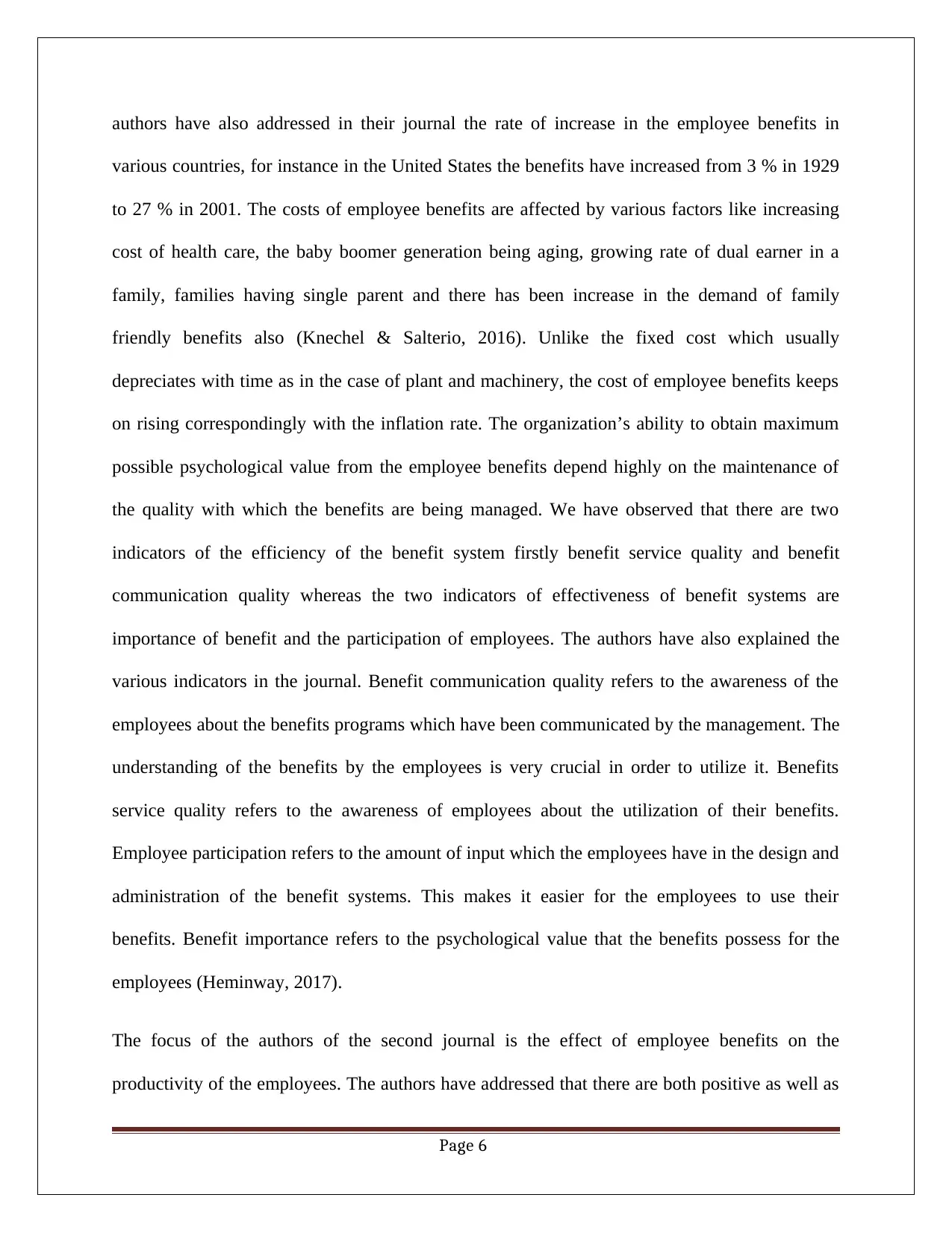
authors have also addressed in their journal the rate of increase in the employee benefits in
various countries, for instance in the United States the benefits have increased from 3 % in 1929
to 27 % in 2001. The costs of employee benefits are affected by various factors like increasing
cost of health care, the baby boomer generation being aging, growing rate of dual earner in a
family, families having single parent and there has been increase in the demand of family
friendly benefits also (Knechel & Salterio, 2016). Unlike the fixed cost which usually
depreciates with time as in the case of plant and machinery, the cost of employee benefits keeps
on rising correspondingly with the inflation rate. The organization’s ability to obtain maximum
possible psychological value from the employee benefits depend highly on the maintenance of
the quality with which the benefits are being managed. We have observed that there are two
indicators of the efficiency of the benefit system firstly benefit service quality and benefit
communication quality whereas the two indicators of effectiveness of benefit systems are
importance of benefit and the participation of employees. The authors have also explained the
various indicators in the journal. Benefit communication quality refers to the awareness of the
employees about the benefits programs which have been communicated by the management. The
understanding of the benefits by the employees is very crucial in order to utilize it. Benefits
service quality refers to the awareness of employees about the utilization of their benefits.
Employee participation refers to the amount of input which the employees have in the design and
administration of the benefit systems. This makes it easier for the employees to use their
benefits. Benefit importance refers to the psychological value that the benefits possess for the
employees (Heminway, 2017).
The focus of the authors of the second journal is the effect of employee benefits on the
productivity of the employees. The authors have addressed that there are both positive as well as
Page 6
various countries, for instance in the United States the benefits have increased from 3 % in 1929
to 27 % in 2001. The costs of employee benefits are affected by various factors like increasing
cost of health care, the baby boomer generation being aging, growing rate of dual earner in a
family, families having single parent and there has been increase in the demand of family
friendly benefits also (Knechel & Salterio, 2016). Unlike the fixed cost which usually
depreciates with time as in the case of plant and machinery, the cost of employee benefits keeps
on rising correspondingly with the inflation rate. The organization’s ability to obtain maximum
possible psychological value from the employee benefits depend highly on the maintenance of
the quality with which the benefits are being managed. We have observed that there are two
indicators of the efficiency of the benefit system firstly benefit service quality and benefit
communication quality whereas the two indicators of effectiveness of benefit systems are
importance of benefit and the participation of employees. The authors have also explained the
various indicators in the journal. Benefit communication quality refers to the awareness of the
employees about the benefits programs which have been communicated by the management. The
understanding of the benefits by the employees is very crucial in order to utilize it. Benefits
service quality refers to the awareness of employees about the utilization of their benefits.
Employee participation refers to the amount of input which the employees have in the design and
administration of the benefit systems. This makes it easier for the employees to use their
benefits. Benefit importance refers to the psychological value that the benefits possess for the
employees (Heminway, 2017).
The focus of the authors of the second journal is the effect of employee benefits on the
productivity of the employees. The authors have addressed that there are both positive as well as
Page 6
Paraphrase This Document
Need a fresh take? Get an instant paraphrase of this document with our AI Paraphraser
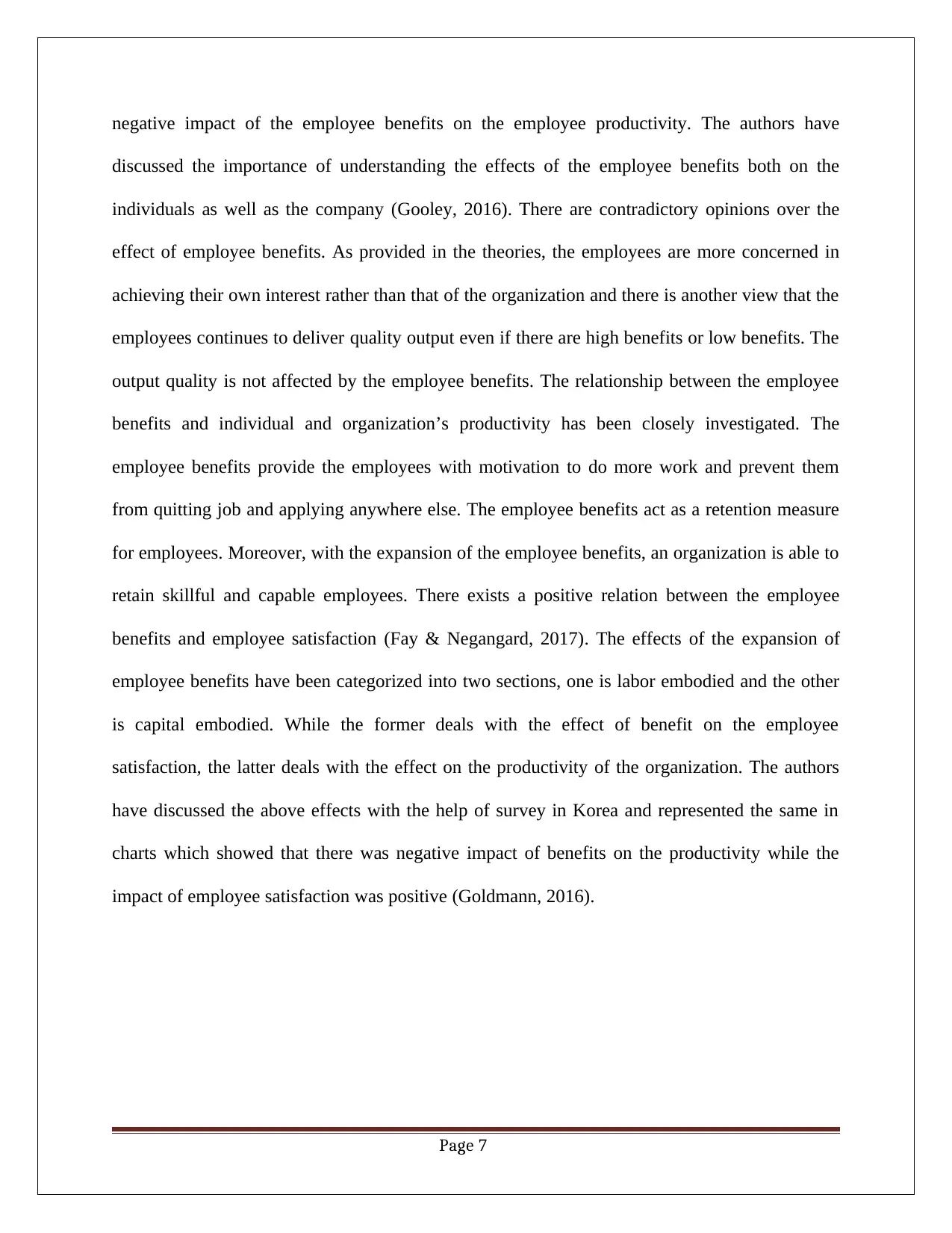
negative impact of the employee benefits on the employee productivity. The authors have
discussed the importance of understanding the effects of the employee benefits both on the
individuals as well as the company (Gooley, 2016). There are contradictory opinions over the
effect of employee benefits. As provided in the theories, the employees are more concerned in
achieving their own interest rather than that of the organization and there is another view that the
employees continues to deliver quality output even if there are high benefits or low benefits. The
output quality is not affected by the employee benefits. The relationship between the employee
benefits and individual and organization’s productivity has been closely investigated. The
employee benefits provide the employees with motivation to do more work and prevent them
from quitting job and applying anywhere else. The employee benefits act as a retention measure
for employees. Moreover, with the expansion of the employee benefits, an organization is able to
retain skillful and capable employees. There exists a positive relation between the employee
benefits and employee satisfaction (Fay & Negangard, 2017). The effects of the expansion of
employee benefits have been categorized into two sections, one is labor embodied and the other
is capital embodied. While the former deals with the effect of benefit on the employee
satisfaction, the latter deals with the effect on the productivity of the organization. The authors
have discussed the above effects with the help of survey in Korea and represented the same in
charts which showed that there was negative impact of benefits on the productivity while the
impact of employee satisfaction was positive (Goldmann, 2016).
Page 7
discussed the importance of understanding the effects of the employee benefits both on the
individuals as well as the company (Gooley, 2016). There are contradictory opinions over the
effect of employee benefits. As provided in the theories, the employees are more concerned in
achieving their own interest rather than that of the organization and there is another view that the
employees continues to deliver quality output even if there are high benefits or low benefits. The
output quality is not affected by the employee benefits. The relationship between the employee
benefits and individual and organization’s productivity has been closely investigated. The
employee benefits provide the employees with motivation to do more work and prevent them
from quitting job and applying anywhere else. The employee benefits act as a retention measure
for employees. Moreover, with the expansion of the employee benefits, an organization is able to
retain skillful and capable employees. There exists a positive relation between the employee
benefits and employee satisfaction (Fay & Negangard, 2017). The effects of the expansion of
employee benefits have been categorized into two sections, one is labor embodied and the other
is capital embodied. While the former deals with the effect of benefit on the employee
satisfaction, the latter deals with the effect on the productivity of the organization. The authors
have discussed the above effects with the help of survey in Korea and represented the same in
charts which showed that there was negative impact of benefits on the productivity while the
impact of employee satisfaction was positive (Goldmann, 2016).
Page 7
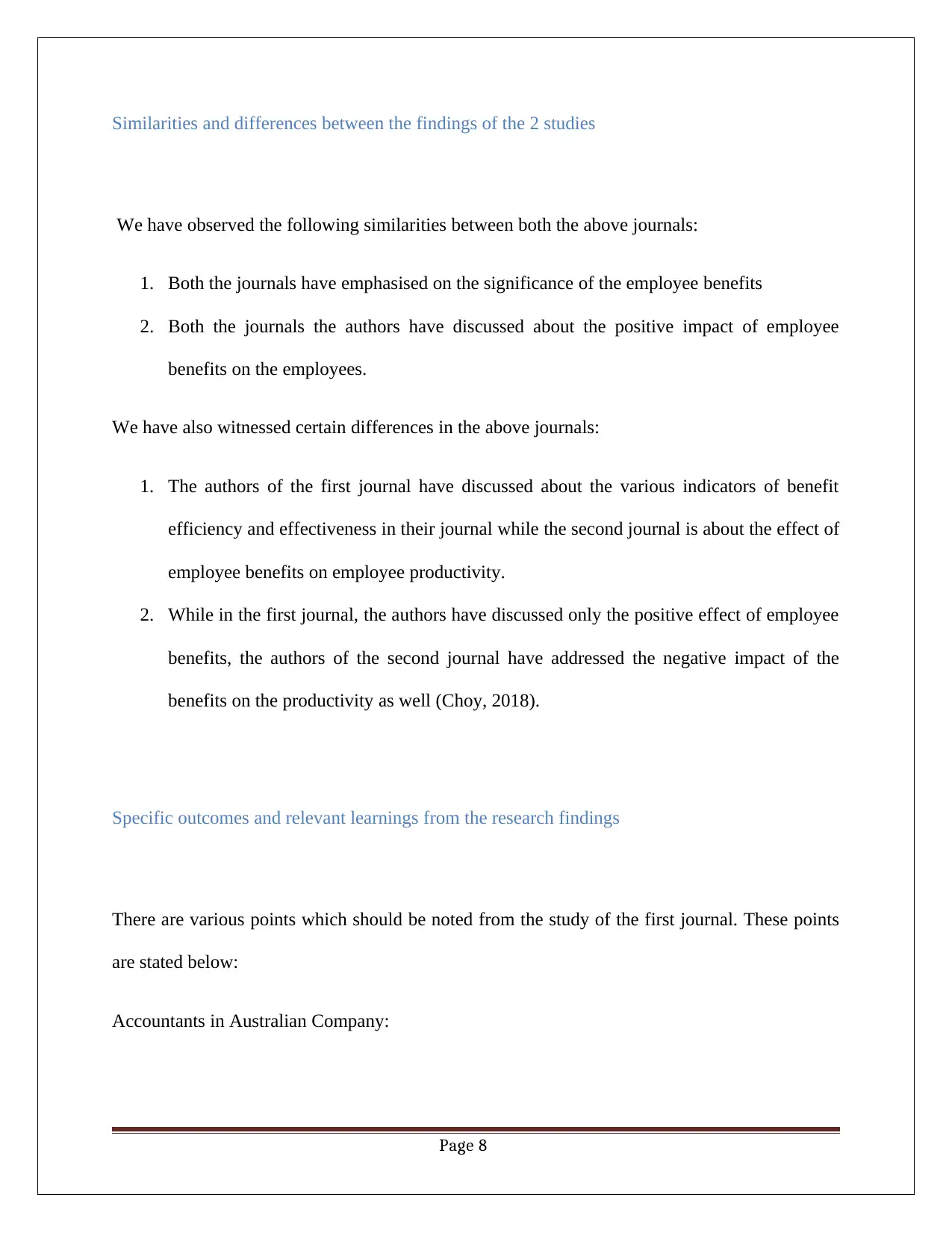
Similarities and differences between the findings of the 2 studies
We have observed the following similarities between both the above journals:
1. Both the journals have emphasised on the significance of the employee benefits
2. Both the journals the authors have discussed about the positive impact of employee
benefits on the employees.
We have also witnessed certain differences in the above journals:
1. The authors of the first journal have discussed about the various indicators of benefit
efficiency and effectiveness in their journal while the second journal is about the effect of
employee benefits on employee productivity.
2. While in the first journal, the authors have discussed only the positive effect of employee
benefits, the authors of the second journal have addressed the negative impact of the
benefits on the productivity as well (Choy, 2018).
Specific outcomes and relevant learnings from the research findings
There are various points which should be noted from the study of the first journal. These points
are stated below:
Accountants in Australian Company:
Page 8
We have observed the following similarities between both the above journals:
1. Both the journals have emphasised on the significance of the employee benefits
2. Both the journals the authors have discussed about the positive impact of employee
benefits on the employees.
We have also witnessed certain differences in the above journals:
1. The authors of the first journal have discussed about the various indicators of benefit
efficiency and effectiveness in their journal while the second journal is about the effect of
employee benefits on employee productivity.
2. While in the first journal, the authors have discussed only the positive effect of employee
benefits, the authors of the second journal have addressed the negative impact of the
benefits on the productivity as well (Choy, 2018).
Specific outcomes and relevant learnings from the research findings
There are various points which should be noted from the study of the first journal. These points
are stated below:
Accountants in Australian Company:
Page 8
⊘ This is a preview!⊘
Do you want full access?
Subscribe today to unlock all pages.

Trusted by 1+ million students worldwide
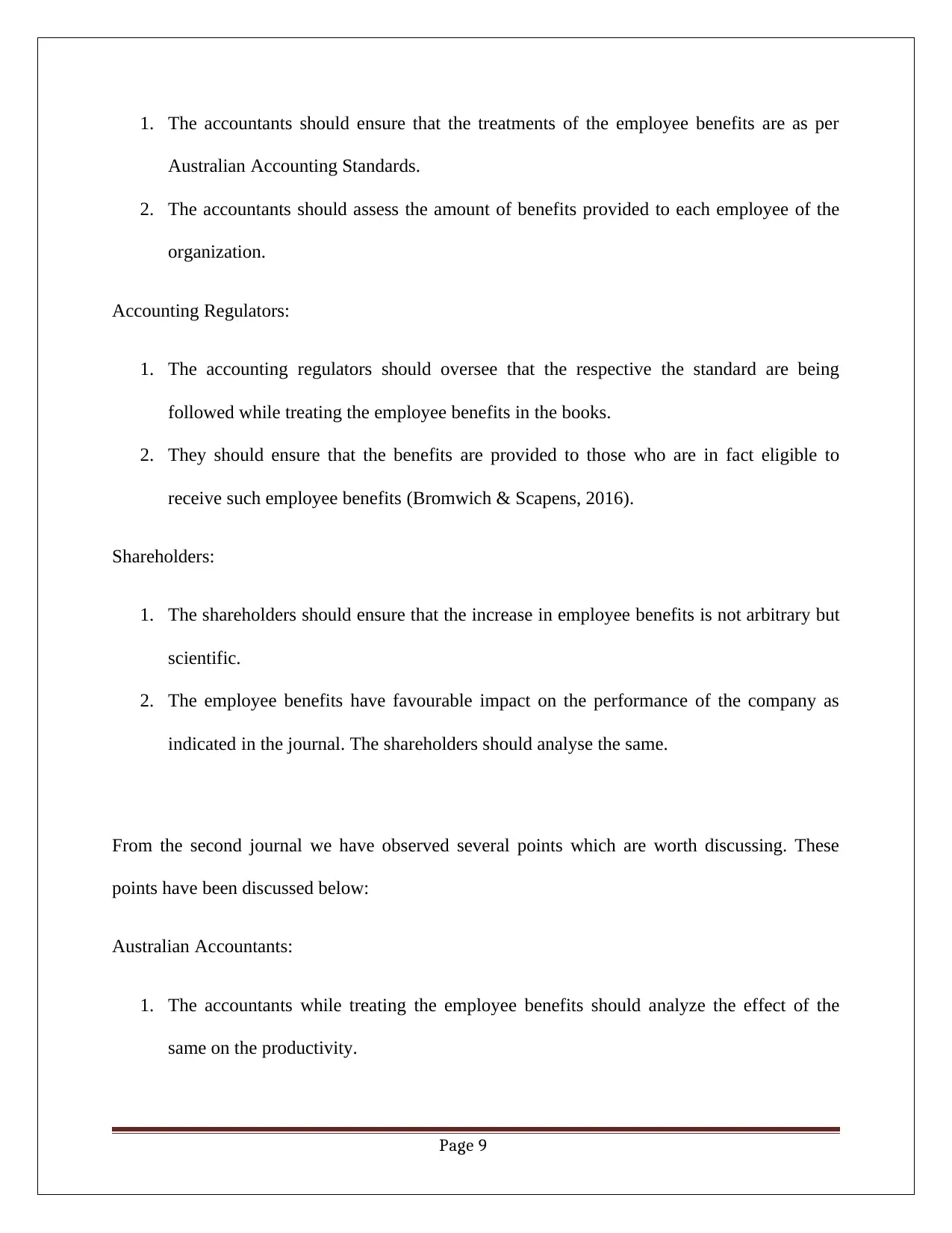
1. The accountants should ensure that the treatments of the employee benefits are as per
Australian Accounting Standards.
2. The accountants should assess the amount of benefits provided to each employee of the
organization.
Accounting Regulators:
1. The accounting regulators should oversee that the respective the standard are being
followed while treating the employee benefits in the books.
2. They should ensure that the benefits are provided to those who are in fact eligible to
receive such employee benefits (Bromwich & Scapens, 2016).
Shareholders:
1. The shareholders should ensure that the increase in employee benefits is not arbitrary but
scientific.
2. The employee benefits have favourable impact on the performance of the company as
indicated in the journal. The shareholders should analyse the same.
From the second journal we have observed several points which are worth discussing. These
points have been discussed below:
Australian Accountants:
1. The accountants while treating the employee benefits should analyze the effect of the
same on the productivity.
Page 9
Australian Accounting Standards.
2. The accountants should assess the amount of benefits provided to each employee of the
organization.
Accounting Regulators:
1. The accounting regulators should oversee that the respective the standard are being
followed while treating the employee benefits in the books.
2. They should ensure that the benefits are provided to those who are in fact eligible to
receive such employee benefits (Bromwich & Scapens, 2016).
Shareholders:
1. The shareholders should ensure that the increase in employee benefits is not arbitrary but
scientific.
2. The employee benefits have favourable impact on the performance of the company as
indicated in the journal. The shareholders should analyse the same.
From the second journal we have observed several points which are worth discussing. These
points have been discussed below:
Australian Accountants:
1. The accountants while treating the employee benefits should analyze the effect of the
same on the productivity.
Page 9
Paraphrase This Document
Need a fresh take? Get an instant paraphrase of this document with our AI Paraphraser
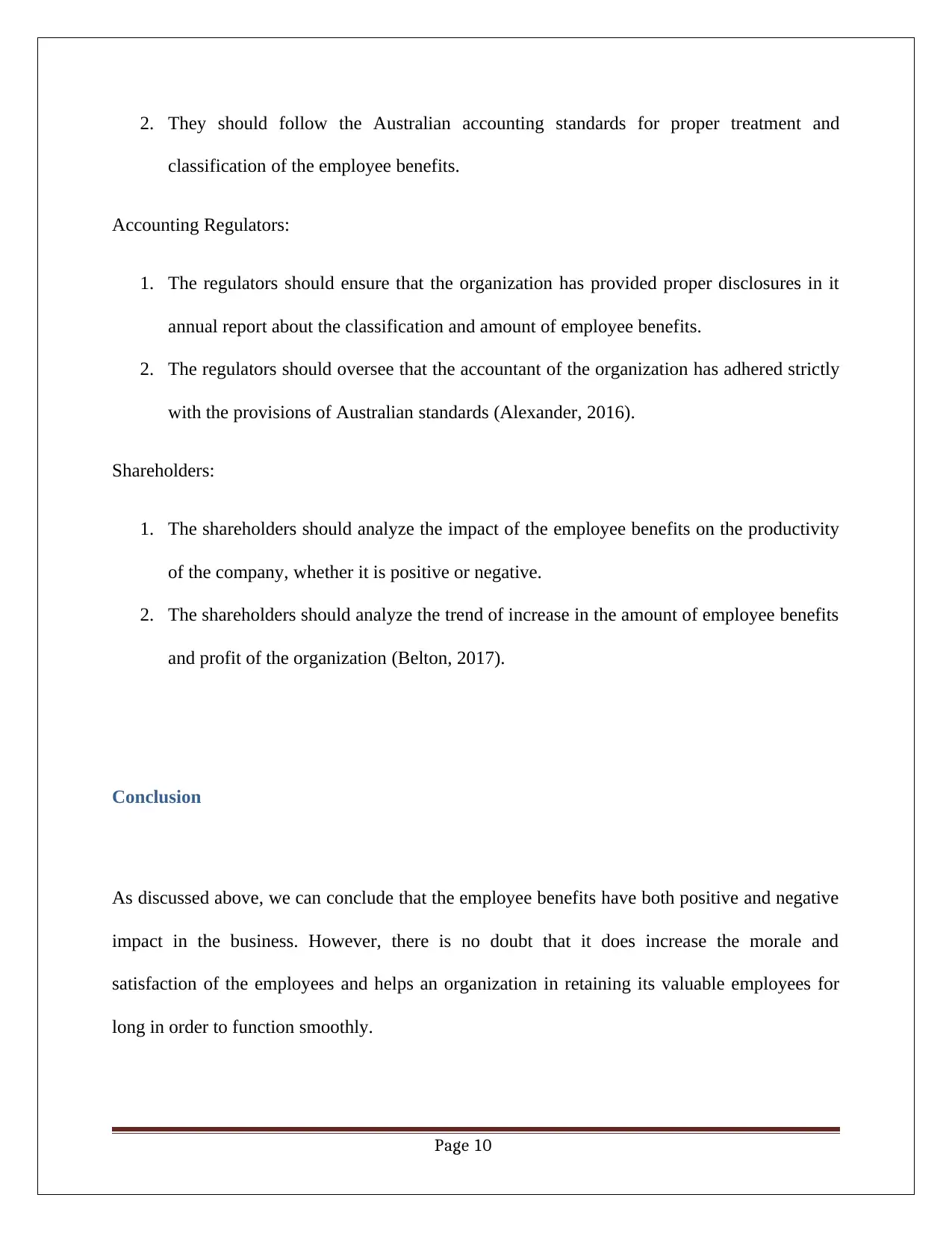
2. They should follow the Australian accounting standards for proper treatment and
classification of the employee benefits.
Accounting Regulators:
1. The regulators should ensure that the organization has provided proper disclosures in it
annual report about the classification and amount of employee benefits.
2. The regulators should oversee that the accountant of the organization has adhered strictly
with the provisions of Australian standards (Alexander, 2016).
Shareholders:
1. The shareholders should analyze the impact of the employee benefits on the productivity
of the company, whether it is positive or negative.
2. The shareholders should analyze the trend of increase in the amount of employee benefits
and profit of the organization (Belton, 2017).
Conclusion
As discussed above, we can conclude that the employee benefits have both positive and negative
impact in the business. However, there is no doubt that it does increase the morale and
satisfaction of the employees and helps an organization in retaining its valuable employees for
long in order to function smoothly.
Page 10
classification of the employee benefits.
Accounting Regulators:
1. The regulators should ensure that the organization has provided proper disclosures in it
annual report about the classification and amount of employee benefits.
2. The regulators should oversee that the accountant of the organization has adhered strictly
with the provisions of Australian standards (Alexander, 2016).
Shareholders:
1. The shareholders should analyze the impact of the employee benefits on the productivity
of the company, whether it is positive or negative.
2. The shareholders should analyze the trend of increase in the amount of employee benefits
and profit of the organization (Belton, 2017).
Conclusion
As discussed above, we can conclude that the employee benefits have both positive and negative
impact in the business. However, there is no doubt that it does increase the morale and
satisfaction of the employees and helps an organization in retaining its valuable employees for
long in order to function smoothly.
Page 10
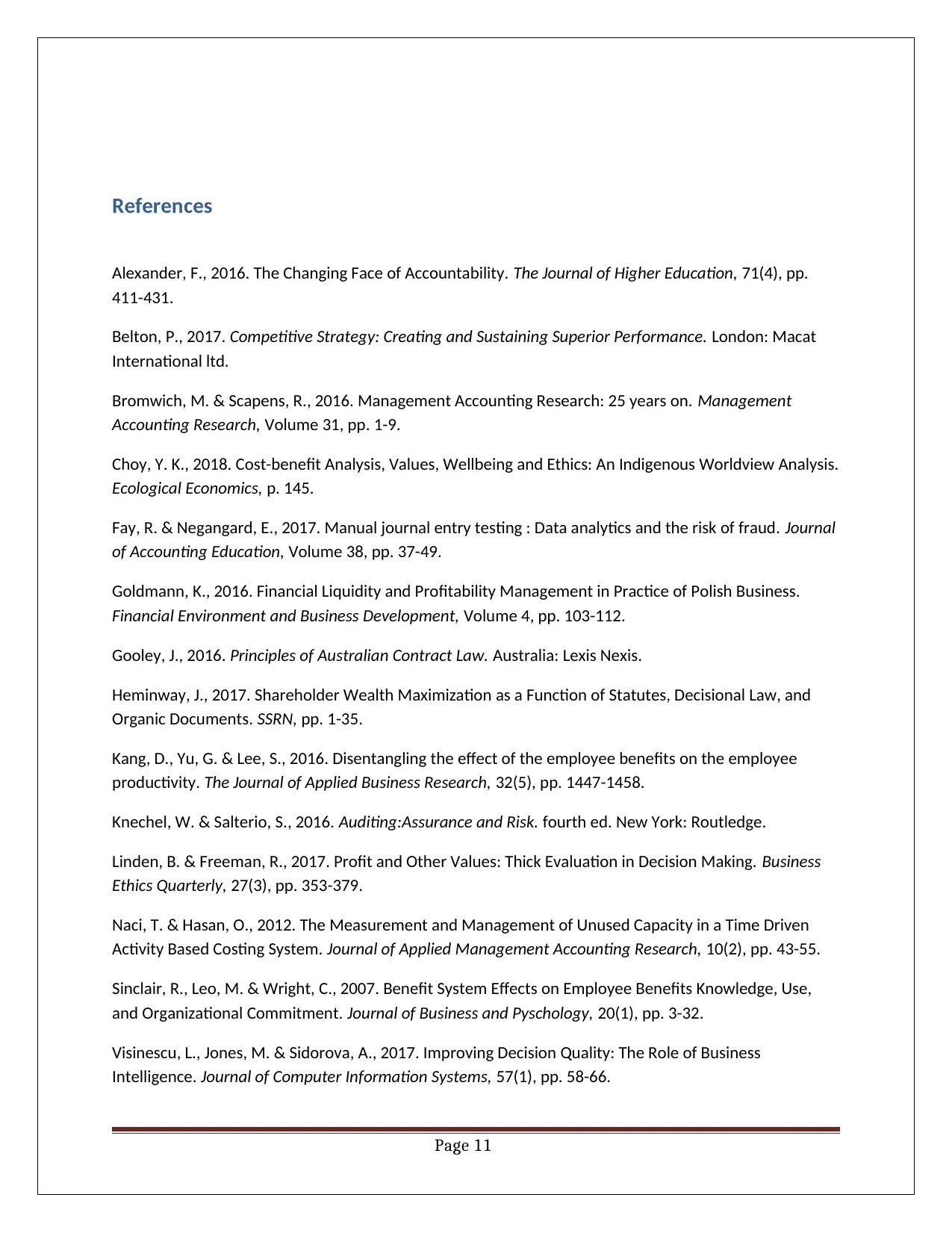
References
Alexander, F., 2016. The Changing Face of Accountability. The Journal of Higher Education, 71(4), pp.
411-431.
Belton, P., 2017. Competitive Strategy: Creating and Sustaining Superior Performance. London: Macat
International ltd.
Bromwich, M. & Scapens, R., 2016. Management Accounting Research: 25 years on. Management
Accounting Research, Volume 31, pp. 1-9.
Choy, Y. K., 2018. Cost-benefit Analysis, Values, Wellbeing and Ethics: An Indigenous Worldview Analysis.
Ecological Economics, p. 145.
Fay, R. & Negangard, E., 2017. Manual journal entry testing : Data analytics and the risk of fraud. Journal
of Accounting Education, Volume 38, pp. 37-49.
Goldmann, K., 2016. Financial Liquidity and Profitability Management in Practice of Polish Business.
Financial Environment and Business Development, Volume 4, pp. 103-112.
Gooley, J., 2016. Principles of Australian Contract Law. Australia: Lexis Nexis.
Heminway, J., 2017. Shareholder Wealth Maximization as a Function of Statutes, Decisional Law, and
Organic Documents. SSRN, pp. 1-35.
Kang, D., Yu, G. & Lee, S., 2016. Disentangling the effect of the employee benefits on the employee
productivity. The Journal of Applied Business Research, 32(5), pp. 1447-1458.
Knechel, W. & Salterio, S., 2016. Auditing:Assurance and Risk. fourth ed. New York: Routledge.
Linden, B. & Freeman, R., 2017. Profit and Other Values: Thick Evaluation in Decision Making. Business
Ethics Quarterly, 27(3), pp. 353-379.
Naci, T. & Hasan, O., 2012. The Measurement and Management of Unused Capacity in a Time Driven
Activity Based Costing System. Journal of Applied Management Accounting Research, 10(2), pp. 43-55.
Sinclair, R., Leo, M. & Wright, C., 2007. Benefit System Effects on Employee Benefits Knowledge, Use,
and Organizational Commitment. Journal of Business and Pyschology, 20(1), pp. 3-32.
Visinescu, L., Jones, M. & Sidorova, A., 2017. Improving Decision Quality: The Role of Business
Intelligence. Journal of Computer Information Systems, 57(1), pp. 58-66.
Page 11
Alexander, F., 2016. The Changing Face of Accountability. The Journal of Higher Education, 71(4), pp.
411-431.
Belton, P., 2017. Competitive Strategy: Creating and Sustaining Superior Performance. London: Macat
International ltd.
Bromwich, M. & Scapens, R., 2016. Management Accounting Research: 25 years on. Management
Accounting Research, Volume 31, pp. 1-9.
Choy, Y. K., 2018. Cost-benefit Analysis, Values, Wellbeing and Ethics: An Indigenous Worldview Analysis.
Ecological Economics, p. 145.
Fay, R. & Negangard, E., 2017. Manual journal entry testing : Data analytics and the risk of fraud. Journal
of Accounting Education, Volume 38, pp. 37-49.
Goldmann, K., 2016. Financial Liquidity and Profitability Management in Practice of Polish Business.
Financial Environment and Business Development, Volume 4, pp. 103-112.
Gooley, J., 2016. Principles of Australian Contract Law. Australia: Lexis Nexis.
Heminway, J., 2017. Shareholder Wealth Maximization as a Function of Statutes, Decisional Law, and
Organic Documents. SSRN, pp. 1-35.
Kang, D., Yu, G. & Lee, S., 2016. Disentangling the effect of the employee benefits on the employee
productivity. The Journal of Applied Business Research, 32(5), pp. 1447-1458.
Knechel, W. & Salterio, S., 2016. Auditing:Assurance and Risk. fourth ed. New York: Routledge.
Linden, B. & Freeman, R., 2017. Profit and Other Values: Thick Evaluation in Decision Making. Business
Ethics Quarterly, 27(3), pp. 353-379.
Naci, T. & Hasan, O., 2012. The Measurement and Management of Unused Capacity in a Time Driven
Activity Based Costing System. Journal of Applied Management Accounting Research, 10(2), pp. 43-55.
Sinclair, R., Leo, M. & Wright, C., 2007. Benefit System Effects on Employee Benefits Knowledge, Use,
and Organizational Commitment. Journal of Business and Pyschology, 20(1), pp. 3-32.
Visinescu, L., Jones, M. & Sidorova, A., 2017. Improving Decision Quality: The Role of Business
Intelligence. Journal of Computer Information Systems, 57(1), pp. 58-66.
Page 11
⊘ This is a preview!⊘
Do you want full access?
Subscribe today to unlock all pages.

Trusted by 1+ million students worldwide
1 out of 14
Related Documents
Your All-in-One AI-Powered Toolkit for Academic Success.
+13062052269
info@desklib.com
Available 24*7 on WhatsApp / Email
![[object Object]](/_next/static/media/star-bottom.7253800d.svg)
Unlock your academic potential
Copyright © 2020–2025 A2Z Services. All Rights Reserved. Developed and managed by ZUCOL.





